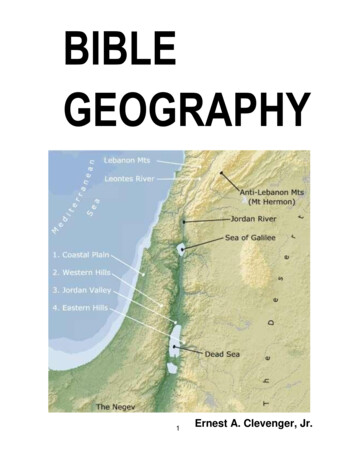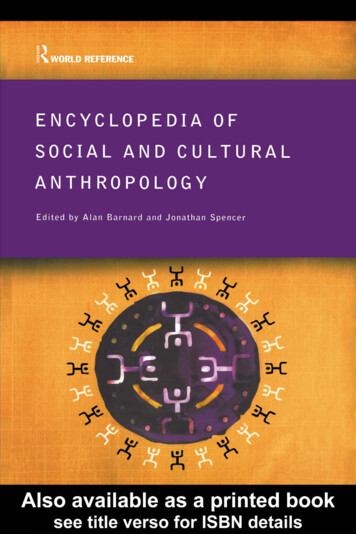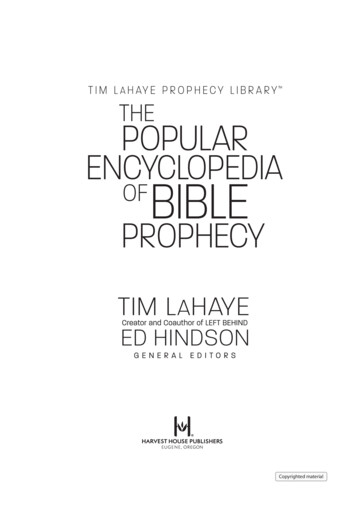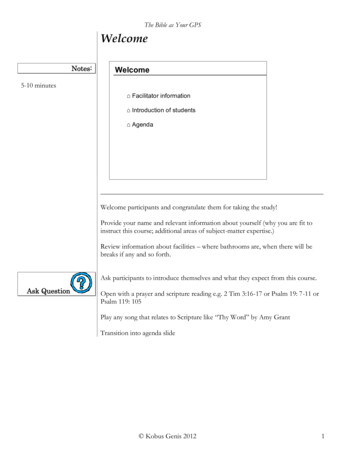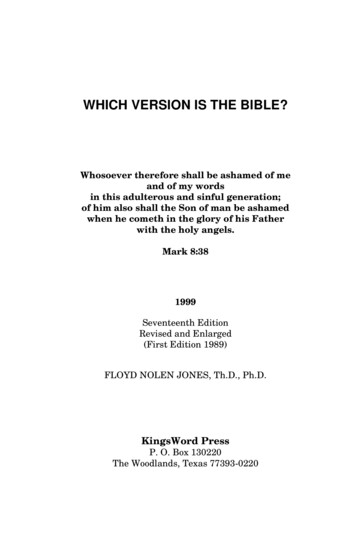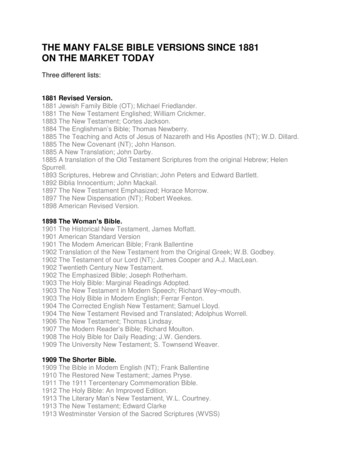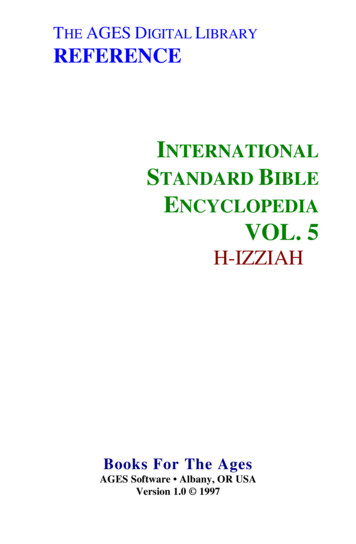
Transcription
THE AGES DIGITAL LIBRARYREFERENCEINTERNATIONALSTANDARD BIBLEENCYCLOPEDIAVOL. 5H-IZZIAHBooks For The AgesAGES Software Albany, OR USAVersion 1.0 1997
2HHA ha ([ja;h,, he’-ah]): In Job 39:25, the Revised Version (British andAmerican) “Aha,” of the battle-horse.See AH, AHA.HAAHASHTARI ha-a-hash’-ta-ri ([yriTv; j] ”a}h,; ha’-achashtari], possibly a corruptionof [yriWjv]a”h;, ha’-ashchuri]): A descendant of Judah (1 Ch 4:6). Thename is probably corrupt. If the emendation suggested above is accepted, itmeans the Ashurites, and is a description of the preceding names.HABAIAH; HOBAIAH ha-ba’-ya , ([hy;b;j}, cha-bhayah], [hy;b;jÜ, chobhayah]): A post-exilicpriestly family which was unable to establish its pedigree. “Habaiah” is theform in Ezr 2:61; in the parallel passage (Neh 7:63), the King JamesVersion has “Habaiah,” and the Revised Version (British and American)“Hobaiah”; in the parallel passage in 1 Esdras 5:38, the form is [ jObdia ,Obdia], Codex Vaticanus, Obbeia.HABAKKUK ha-bak’-uk , hab’-a-kuk :I. THE AUTHOR.1. Name:Habakkuk ([qWQb”j}, chabhaqquq]) means “embrace,” or “ardentembrace.” Some of the ancient rabbis, connecting the name with 2 Ki 4:16,“Thou shalt embrace a son,” imagined that the prophet was the son of theShunammite woman. The Septuagint form of the name, Hambakoum;
3Theodotion Hambakouk, presupposes the Hebrew chabbaquq. A similarword occurs in Assyrian as the name of a garden plant.2. Life:Practically nothing is known of Habakkuk. The book bearing his namethrows little light upon his life, and the rest of the Old Testament is silentconcerning him; but numerous legends have grown up around his name.The identification of the prophet with the son of the Shunammite woman isone. Another, connecting Isa 21:6 with Hab 2:1, makes Habakkuk thewatchman set by Isaiah to watch for the fall of Babylon. One of therecensions of the Septuagint text of Bel and the Dragon declares that thestory was taken “from the prophecy of Habakkuk, the son of Jesus of thetribe of Levi.” This must refer to an unknown apocryphal book ascribed toour prophet. What authority there may be for calling his father Jesus we donot know. The claim that he was of the tribe of Levi may be based uponthe presence of the musical note at the end of the third chapter. Accordingto the Lives of the Prophets, ascribed, though perhaps erroneously, toEpiphanius, bishop of Salamis in Cyprus during the latter part of the 4thcentury AD, he belonged to [Bethtsohar], of the tribe of Simeon. A veryinteresting story is found in Bel and the Dragon (33-39), according towhich Habakkuk, while on his way to the field with a bowl of pottage, wastaken by an angel, carried to Babylon and placed in the lions den, whereDaniel ate the pottage, when Habakkuk was returned to his own place.According to the Lives, Habakkuk died two years before the return of theexiles from Babylon. All these legends have little or no historical value.II. THE BOOK.1. Interpretation of Habakkuk 1 and 2:It is necessary to consider the interpretation of Hab 1 and 2 before givingthe contents of the book, as a statement of the contents of these chapterswill be determined by their interpretation. The different interpretationsadvocated may be grouped under three heads:(1) According to the first view: Hab 1:2-4: The corruption of Judah; theoppression of the righteous Jews by the wicked Jews, which calls for theDivine manifestation in judgment against the oppressors. 1:5-11: Yahwehannounces that He is about to send the Chaldeans to execute judgment.1:12-17: The prophet is perplexed. He cannot understand how a righteous
4God can use these barbarians to execute judgment upon a people morerighteous than they. He considers even the wicked among the Jews betterthan the Chaldeans. 2:1-4: Yahweh solves the perplexing problem byannouncing that the exaltation of the Chaldeans will be but temporary; inthe end they will meet their doom, while the righteous will live. 2:5-20:Woes against the Chaldeans.(2) The second view finds it necessary to change the present arrangementof Hab 1:5-11; in their present position, they will not fit into theinterpretation. For this reason Wellhausen and others omit these verses as alater addition; on the other hand, Giesebrecht would place them before 1:2,as the opening verses of the prophecy. The transposition would require afew other minor changes, so as to make the verses a suitable beginning andestablish a smooth transition from 1:11 to 1:2. Omitting the troublesomeverses, the following outline of the two chapters may be given: 1:2-4: Theoppression of the righteous Jews by the wicked Chaldeans. 1:12-17:Appeal to Yahweh on behalf of the Jews against their oppressors. 2:1-4:Yahweh promises deliverance (see above). 2:5-20: Woes against theChaldeans.(3) The third view also finds it necessary to alter the present order ofverses. Again Hab 1:5-11, in the present position, interferes with theory;therefore, these verses are given a more suitable place after 2:4. Accordingto this interpretation the outline is as follows: 1:2-4: Oppression of therighteous Jews by the wicked Assyrians (Budde) or Egyptians (G. A.Smith). 1:12-17: Appeal to Yahweh on behalf of the oppressed against theoppressor. 2:1-4: Yahweh promises deliverance (see above). 1:5-11: TheChaldeans will be the instrument to execute judgment upon the oppressorsand to bring deliverance to the Jews. 2:5-20: Woes against the Assyrians orEgyptians.A full discussion of these views is not possible in this article (see Eiselen,Minor Prophets, 466-68). It may be sufficient to say that on the whole thefirst interpretation, which requires no omission or transposition, seems tosatisfy most completely the facts in the case.2. Contents:The contents of Hab 1 and 2 are indicated in the preceding paragraph. Hab3 contains a lyrical passage called in the title “Prayer.” The petitionerspeaks for himself and the community. He remembers the mighty works of
5Yahweh for His people; the thought of them causes him to tremble;nevertheless, he calls for a repetition of the ancient manifestations (3:2). Inmajestic pictures the poet describes the wonderful appearances of Yahwehin the past (3:3-11) for His chosen people (3:12-15). The remembrance ofthese manifestations fills the Psalmist with fear and trembling, but also withjoy and confidence in the God of his salvation (3:16-19).3. Style:Only the Hebrew student can get an adequate idea of the literary excellenceof the Book of Habakkuk. “The literary power of Habakkuk,” says Driver,“is considerable. Though his book is a brief one, it is full of force; hisdescriptions are graphic and powerful; thought and expression are alikepoetic; he is still a master of the old classical style, terse, parallelistic,pregnant; there is no trace of the often prosaic diffusiveness whichmanifests itself in the writings of Jeremiah and Ezekiel. And if Hab 3 be his,he is, moreover, a lyric poet of high order; the grand imagery and therhythmic flow of this ode will bear comparison with some of the finestproductions of the Hebrew muse.”4. Integrity:More than half of the book, including Hab 1:5-11; 2:9-20, and chapter 3entire, has been denied to the prophet Habakkuk. If the prophecy is rightlyinterpreted (see above), no valid reason for rejecting 1:5-11 can be found.Hab 2:9-20 are denied to Habakkuk chiefly on two grounds:(1) The “woes” are said to be in part, at least, unsuitable, if supposedto be addressed to the Chaldean king. This difficulty vanishes when it isborne in mind that the king is not addressed as an individual, but asrepresenting the policy of the nation, as a personification of the nation.(2) Some parts, especially 2:12-14, “consist largely of citations andreminiscences of other passages, including some late ones” (compare2:12 with Mic 3:10; Hab 2:13 with Jer 51:58; Hab 2:14 with Isa 11:9;Hav 2:16b with Jer 25:15,16; Hab 2:18-20 with Isa 44:9 ff; 46:6,7; Jer10:1-16). Aside from the fact that the argument from literary parallelsis always precarious, in this case the resemblances are few in numberand of such general character that they do not necessarily presupposeliterary dependence. Habakkuk 3 is denied to the prophet even morepersistently, but the arguments are by no means conclusive. The fact
6that the chapter belongs to the psalm literature does not prove a latedate unless it is assumed, without good reasons, that no psalmsoriginated in the preexilic period. Nor do the historical allusions, whichare altogether vague, the style, the relation to other writers, and thecharacter of the religious ideas expressed, point necessarily to a latedate. The only doubtful verses are 2:16 ff, which seem to allude to acalamity other than the invasion of the Chaldeans; and Driver says, notwithout reason, “Had the poet been writing under the pressure of ahostile invasion, the invasion itself would naturally have been expectedto form a prominent feature in this picture.” Hence, while it may beimpossible to prove that Habakkuk is the author of the prayer, it isequally impossible to prove the contrary; and while there are a fewindications which seem to point to a situation different from that ofHabakkuk, they are by no means definite enough to exclude thepossibility of Habakkuk’s authorship.III. THE TIME.1. Date:The question of date is closely bound up with that of interpretation. Budde,on theory that the oppressors, threatened with destruction, are theAssyrians (see above, 3), dates the prophecy 621 to 615 BC. Granting thatthe Assyrians are in the mind of the prophet, the date suggested byBetteridge (AJT, 1903, 674 ff), circa 701 BC, is to be preferred; but if theAssyrians are not the oppressors, then with the Assyrians fall the datesproposed by Budde and Betteridge. If the prophecy is directed againstEgypt, we are shut up to a very definite period, between 608 and 604 BC,for the Egyptian supremacy in Judah continued during these years only. Ifthe Egyptians are not the oppressors, another date will have to be sought.If the Chaldeans are the oppressors of Judah, the prophecy must beassigned to a date subsequent to the battle of Carchemish in 605-604, foronly after the defeat of the Egyptians could the Chaldeans carry out apolicy of world conquest; and it was some years after that event that theChaldeans first came into direct contact with Judah. But on this theory,Hab 1:2-4,12 ff; 2:8 ff, presupposes the lapse of a considerable period ofconquest, the subduing of many nations, the cruel oppression of Judah forsome length of time; therefore, Nowack is undoubtedly correct, on thistheory, in bringing the prophecy down to a period subsequent to the firstexile in 597, or, as he says, “in round numbers about 590 BC.”
7A different date must be sought if Hab 1:2-4 is interpreted as referring tothe oppression of Jews by Jews, and 1:5 ff, as a threat that Yahweh willraise up the Chaldeans, already known as a nation thirsting for blood, topunish the wickedness of Judah. These verses would seem to indicate(1) that the Chaldeans had not yet come into direct contact with Judah,and(2) that they had already given exhibitions of the cruel character oftheir warfare. Nebuchadnezzar advanced against Judah about 600 BC;but the years since the fall of Nineveh, in 607-606, and the battle ofCarchemish, in 605-604, had given abundant opportunity to theChaldeans to reveal their true character, and to the prophet and hiscontemporaries to become acquainted with this cruel successor ofNineveh. On this theory, therefore, the prophetic activity of Habakkukmust be assigned to shortly before 600 BC.2. Occasion:If Habakkuk prophesied about 600 BC, he lived under King Jehoiakim.The pious and well-meaning Josiah had been slain in an attempt to stop theadvance of Egypt against Assyria. With his death the brief era of reformcame to an end. After a reign of three months Jehoahaz was deposed byPharaoh-necoh, who placed Jehoiakim on the throne. The latter wasselfish, tyrannical and godless. In a short time the deplorable conditions ofManasseh’s reign returned. It was this situation that caused the prophet’sfirst perplexity: “O Yahweh, how long shall I cry, and thou wilt not hear? Icry out unto thee of violence, and thou wilt not save” (Hab 1:2).IV. ITS TEACHING.In the Book of Hab a new type of prophecy appears. The prophets wereprimarily preachers and teachers of religion and ethics. They addressedthemselves to their fellow-countrymen in an attempt to win them back toYahweh and a righteous life. Not so Habakkuk. He addresses himself toYahweh, questioning the justice or even the reality of the DivineProvidence. He makes complaint to God and expostulates with Him. Theprophet Habakkuk, therefore, is a forerunner of the author of the Book ofJob. “As a whole, his book is the fruit of religious reflection. It exhibits thecommunings and questionings of his soul — representative, no doubt, ofmany other pious spirits of the time — with God; and records the answers
8which the Spirit of God taught him for his own sake and for the sake oftried souls in every age.Habakkuk has been called the prophet of faith. He possessed a strong,living faith in Yahweh; but he, like many other pious souls, was troubledand perplexed by the apparent inequalities of life. He found it difficult toreconcile these with his lofty conception of Yahweh. Nevertheless, he doesnot sulk. Boldly he presents his perplexities to Yahweh, who points theway to a solution, and the prophet comes forth from his trouble with a faithstronger and more intense than ever. It is in connection with his attempts tosolve the perplexing problems raised by the unpunished sins of hiscountrymen and the unlimited success of the Chaldeans that Habakkukgives utterance to two sublime truths:1. The Universal Supremacy of Yahweh:Yahweh is interested not only in Israel. Though Habakkuk, like the otherprophets, believes in a special Divine Providence over Israel, he is equallyconvinced that Yahweh’s rule embraces the whole earth; the destinies of allthe nations are in His hand. The Chaldeans are punished not merely fortheir sins against Judah, but for the oppression of other nations as well.Being the only God, He cannot permit the worship of other deities.Temporarily the Chaldeans may worship idols, or make might their god,they may “sacrifice unto their net,” and burn incense “unto their drag,”because by them “their portion is fat and their food plenteous”; butYahweh is from everlasting, the Holy One, and He will attest Hissupremacy by utterly destroying the boastful conqueror with his idols.2. Faithfulness the Guarantee of Permanency:The second important truth is expressed in Hab 2:4: “The righteous shalllive by his faith” (the American Revised Version, margin “faithfulness”).Faithfulness assures permanency. The thought expressed by the prophet isnot identical with that expressed by the apostle who quotes the words (Gal3:11); nevertheless, the former also gives expression to a truth of profoundsignificance. “Faithfulness” is with the prophet an external thing; it signifiesintegrity, fidelity, steadfastness under all provocations; but this implies, in areal sense, the New Testament conception of faith as an active principle ofright conduct. A living faith determines conduct; religion and ethics gohand in hand, and especially in the hour of adversity a belief in Yahweh andunflinching reliance upon Him are the strongest preservers of fidelity and
9integrity. Faith without works is dead; faith expresses itself in life.Habakkuk places chief emphasis upon the expressions of faith, and he doesso rightly; but in doing this he also calls attention, by implication at least, tothe motive power behind the external manifestations. As an expression ofliving faith, 3:17-19 is not surpassed in the Old Testament.LITERATURE.Commentaries on the Minor Prophets by Ewald, Pusey, Keil, Orelli, G. A.Smith (Expositor’s Bible), Driver (New Century Bible), Eiselen; A. B.Davidson, Commentary on “Nah,” “Hab,” “Zeph” (Cambridge Bible); A.F. Kirkpatrick, Doctrine of the Prophets; F. C. Eiselen, Prophecy and theProphets; F. W. Farrar, Minor Prophets (“Men of the Bible”); Driver,LOT; HDB, article “Habakkuk”; EB, article “Habakkuk.”Frederick Carl EiselenHABAKKUK, THE PRAYER OFSee BETHHORON, BATTLE OF.HABAZINIAH([hy;n]Xib”j}, chabhatstsinyah]. Thus in the King James Version, but morecorrectly as in the Revised Version (British and American)HABAZZINIAH, hab-a-zi-ni’-a (Jer 35,3)): The grandfather of Jaazaniah,who was the leader of the Rechabites who were tested by Jeremiah as totheir obedience to their ancestor’s command with reference to wine. Theirloyalty to the commands of Jonadab was effectively used by Jeremiah in anappeal to the people of Judah to obey the words of Yahweh.HABERGEON hab’-er-jun , ha-bur’-jun , the King James Version ([ar;jT} ”,tachara’]): In the Revised Version (British and American), Ex 28:32;39:23, etc., “coat of mail”; in Job 41:26, “pointed shaft,” margin “coat ofmail.”See ARMS, ARMOR.
10HABITATION hab-i-ta’-shun : Properly a place of sojourn or dwelling. The term in theKing James Version representing some 16 Hebrew words (moshabh, ma on, mishkan, naweh, etc.), and 5 Greek words, is variously changed incertain passages in the Revised Version (British and American), as Gen49:5, “swords”; Lev 13:46 “dwelling”; Job 5:24; Jer 25:30b,37, “fold”; Ps89:14; 97:2, etc., “foundation”; Ps 132:5, “tabernacle”; Lk 16:9,“tabernacles,” etc. Conversely, “habitation” appears in the Revised Version(British and American) for the King James Version “dwelling place” in 2Ch 30:27; Ps 79:7, “house”; Ps 83:12; 2 Cor 5:2, “tabernacle,” Acts 7:46,etc.See HOUSE.James OrrHABOR ha’-bor ([rwObj;, chabhor]; [ Jabw r, Habor], [ Jabiw r, Habior]; Isidorof Charax, Aburas ([ jAboura v, Abouras]), Zosias, Aboras):1. ITS POSITION AND COURSE:Is described in 2 Ki 17:6; 18:11 (compare 1 Ch 5:26) as “the river ofGozan.” It is the Arabic Khabur, and flows in a southerly direction fromseveral sources in the mountains of Karaj Dagh (Mons Masius), which, inthe 37th parallel, flanks the valley of the Tigris on the West. The riverultimately joins the Euphrates after receiving its chief tributary, theJaghjagha Su (Mygdonius), at Circesium (Kirkisiyeh).2. ETYMOLOGIES OF HABOR:The meaning of its name is doubtful, but Delitzsch has suggested aSumerian etymology, namely, habur, “the fish-waterway,” or it may beconnected with “mother Hubur’” a descriptive title of Tiamat (seeMERODACH; RAHAB).3. HISTORICAL REFERENCES:Layard found several interesting Assyrian remains in the district, includingman-headed bulls bearing the name of Muses-Ninip, possibly an Assyrian
11governor. Tiglath-pileser I (circa 1120 BC) boasts of having killed 10mighty elephants in Haran and on the banks of the Habor; and Assur-nacirapli (circa 880 BC), after conquering Harsit (Harrit, Harmis), subjugatedthe tract around piate sa nar Habur, “the mouths of the Habor.” Accordingto 2 Ki and 1 Chronicles, Shalmaneser IV and Sargon transported theexiled Israelites thither. Philological considerations exclude theidentification of the Chebar of Ezek 13, etc., with the Habor.T. G. PinchesHACALIAH hak-a-li’-a ([hy;lk] ”j}, chakhalyah], meaning doubtful, perhaps “waitfor Yahweh”; the King James Version Hachaliah): Father of Nehemiah(Neh 11; 10:1).HACHILAH, HILL OF ha-ki’-la , hak’-i-la , ([hl;ykij}, chakhilah]): A hill in the wildernessof Judah, associated with the wanderings of David. It is stated (1 Sam23:19) to be “on the South of the desert” (or Jeshimon), and (1 Sam 26:1)to be “before (on the front (i.e. edge) of) the desert.” It was near Ziph andMaon. The only plausible hypothesis is that it is represented by the ridgeDhahret el-Kolah in the wilderness of Ziph, toward the desert of En-gedi(PEF, III, 313, Sh XXI).HACHMONI; HACHMONITE hak-mo’-ni , hak’-mo-ni , or probably ([yniwOmk]j”, chakhmoni],“wise”): The same word is rendered “Hachmoni,” a proper name, in 1 Ch27:32 and “a Hachmonite” in 1 Ch 11:11. The form of the Hebrew wordsuggests that the latter translation should be adopted in both passages, andthat it describes the warrior in one case, and the companion or tutor ofDavid’s sons in the other, as a member of a certain family — a Hachmoniteof which nothing further is known. 2 Sam 23:8, “Josheb-basshebeth aTahchemonite,” bears the marks of a corrupt text, and should be parallelwith 1 Ch 11:11 so far as the name goes, reading “Jashobeam theHachmonite.” So Klostermann, Driver, Wellhausen, Budde, etc.George Rice Hovey
12HADAD ha’-dad :(1) ([dd”j}, chadhadh], “sharpness”): One of the twelve sons of Ishmael(Gen 25:15, where the King James Version, following a mistake in Hebrewtext, has “Hadar”; but “Hadad” is found in parallel passage 1 Ch 1:30; theRevised Version (British and American) reads “Hadad” in both places).(2) ([dd”h}, hadhadh]): A king of Edom, son of Bedad (Gen 36:35,36parallel 1 Ch 1:46,47), “who smote Midian in the field of Moab,” andwhose “city was Avith.”(3) Another king of Edom, written “Hadar” in Gen 36:39 by a copyist’smistake, but “Hadad” in the parallel passage 1 Ch 1:50,51. His city wasPau or Palestine.(4) A member of the royal family of Edom in David’s time, who as a childescaped Joab’s slaughter of the Edomites, and fled to Egypt. On David’sdeath he returned to Edom, where he made trouble for Solomon by stirringup the Edomites against the rule of Israel (1 Ki 11:14-22,25).(5) The supreme god of Syria, whose name is found in Scripture in thenames of Syrian kings, Benhadad, Hadadezer. The god Hadad ( perhaps,“maker of loud noise”) is mentioned in Assyrian inscriptions, and called onthe monolith of Shalmaneser “the god of Aleppo.” In the Assyrianinscriptions he is identified with the air-god Rammon or Rimmon. Theunion of the two names in Zec 12:11 suggests this identity, though thereference is uncertain, some regarding Hadadrimmon as the name of aplace, others as the name of the god — “Hadad (is) Rimmon.” The name“Hadad” is found in various other forms: Adad, Dadu, and Dadda. See A.H. Sayce in HDB under the word “Hadad.”George Rice HoveyHADADEZER had-ad-e’-zer ([rz,[d, d] ”h}, hadhadh ezer]; so 2 Sam 8; 1 Ki 11:23,but [rz,[r, d] ”h}, hadhar ezer], 2 Sam 10; 1 Ch 18): Mentioned inconnection with David’s wars of conquest (2 Sam 8:3 ff; 2 Sam 10:1-19; 1Ch 18:3 ff); was king of Zobah in Syria. The exact position and size of thisSyrian principality are uncertain, but it seems to have extended in David’s
13time southward toward Ammon and eastward to the Euphrates. When theAmmonites had put themselves in the wrong with David by the insult doneto his ambassadors (2 Sam 10:1-5) they summoned to their aid against theincensed king of Israel the Syrians of various adjoining principalities,among them the Syrians of Zobah under Hadadezer, the son of Rehob. Thestrategy of Joab, who set the force under command of Abishai his brotherin array against the Ammonites, and himself attacked the Syrian allies, wonfor Israel a decisive victory. Not content with this result, Hadadezergathered together another Syrian force, summoning this time also “theSyrians that were beyond the River” (2 Sam 10:16), with Shobach thecaptain of his host at their head. On this occasion David himself tookcommand of the Israelite forces and again defeated them near Helam,Shobach being left dead on the field. Hadadezer and his Syrian vassals,finding resistance hopeless, “made peace with Israel and served them” (2Sam 10:19). For the name Hadador Hadarezer, see BENHADAD.LITERATURE.Winckler, Geschichte Israels, I, 137 ff; McCurdy, HPM, 204; Maspero,The Struggle of the Nations, 731.T. Nicol.HADADRIMMON ha-dad-rim’-on , had-ad-rim’-on ([ˆwOMri dd”h}, hadhadhrimmon]): A name which occurs, along with Megiddon, in Zec 12:11. Itwas long thought that this was a place in the plain of Megiddo, and that themourning referred to was that for Josiah, slain in battle with Pharaoh-necoh(2 Ki 23:29). This last, however, was certainly at Jerusalem. Jerome(Comm. on Zec) identifies Hadadrimmon with Maximianopolis, a villagenear Jezreel, probably Legio, the ancient Megiddo. Possibly, however, theform “Hadadrimmon” has arisen through the combination of two divinenames; and the weeping may be that for Tammuz (Ezek 8:14), with whomthe old Semitic deity had become confused in the popular mind.W. EwingHADAR ha’-dar (Gen 36:39).
14See HADAD (3).HADAREZER had-ar-e’-zer .See HADADEZER.HADASHAH ha-da’-sha , had’-a-sha ([hv;d;j}, chadhashah], “new”): A town inthe Shephelah of Judah, named with Zenan and Migdal-gad (Josh 15:37).According to the Mishna ([ Erubhin], v. 6), it was the smallest town inJudah. It is not identified.HADASSAH ha-das’-a ([hS;d”h}, hadhaqqah], “myrtle”): The Hebrew name (Est2:7) formerly borne by ESTHER (which see).HADATTAH ha-dat’-a ([hT;d”j}, chadhattah], “new”):See HAZOR.HADES ha’-dez ([ {Aidhv, Haides], [a[ dhv, haides], “not to be seen”): Hades,Greek originally Haidou, in genitive, “the house of Hades,” then, asnominative, designation of the abode of the dead itself. The word occurs inthe New Testament in Mt 11:23 (parallel Lk 10:15); Mt 16:18; Lk 16:23;Acts 2:27,31; Rev 1:18; 6:8; 20:13 f. It is also found in Textus Receptus ofthe New Testament 1 Cor 15:55, but here the correct reading(Tischendorf, Westcott and Hort, The New Testament in Greek, theRevised Version (British and American)) is probably Thanate, “O Death,”instead of Haide, “O Hades.” the King James Version renders “Hades” by“hell” in all instances except 1 Cor 15:55, where it puts “grave” (margin“hell”) in dependence on Hos 13:14. the Revised Version (British andAmerican) everywhere has “Hades.”
151. IN OLD TESTAMENT: SHEOL:In the Septuagint Hades is the standing equivalent for Sheol, but alsotranslates other terms associated with death and the state after it. TheGreek conception of Hades was that of a locality receiving into itself all thedead, but divided into two regions, one a place of torment, the other ofblessedness. This conception should not be rashly transferred to the NewTestament, for the latter stands not under the influence of Greek paganbelief, but gives a teaching and reflects a belief which model their idea ofHades upon the Old Testament through the Septuagint. The Old TestamentSheol, while formally resembling the Greek Hades in that it is the commonreceptacle of all the dead, differs from it, on the one hand, by the absenceof a clearly defined division into two parts, and, on the other hand, by theemphasis placed on its association with death and the grave as abnormalfacts following in the wake of sin. The Old Testament thus concentratesthe partial light it throws on the state after death on the negative,undesirable side of the prospect apart from redemption. When in theprogress of Old Testament revelation the state after death begins to assumemore definite features, and becomes more sharply differentiated independence on the religious and moral issue of the present life this is notaccomplished in the canonical writings (otherwise in the apocalypticliterature) by dividing Sheol into two compartments, but by holding forthto the righteous the promise of deliverance from Sheol, so that the latterbecomes more definitely outlined as a place of evil and punishment.2. IN THE NEW TESTAMENT: HADES:The New Testament passages mark a distinct stage in this process, andthere is, accordingly, a true basis in Scripture for the identification in acertain aspect of Sheol — Hades — with hell as reflected in the KingJames Version. The theory according to which Hades is still in the NewTestament the undifferentiated provisional abode of all the dead until theday of judgment, with the possibility of ultimate salvation even for those ofits inmates who have not been saved in this life, is neither in harmony withthe above development nor borne out by the facts of New Testamentusage. That dead believers abide in a local Hades cannot be proven from 1Thess 4:16; 1 Cor 15:23, for these passages refer to the grave and thebody, not to a gathering-place of the dead. On the other hand Lk 23:43; 2Cor 5:6-8; Phil 1:23; Rev 6:9; 7:9 ff; 15:2 ff teach that the abode ofbelievers immediately after death is with Christ and God.
163. ACTS 2:27,31:It is, of course, a different matter, when Hades, as not infrequently alreadythe Old Testament Sheol, designates not the place of the dead but the stateof death or disembodied existence. In this sense even the soul of Jesus wasin Hades according’ to Peter’s statement (Acts 2:27,31 — on the basis ofPs 16:10). Here the abstract sense is determined by the parallel expression,“to see corruption” None the less from a comparatively early date thispassage has been quoted in support of the doctrine of a local descent ofChrist into Hades.4. REV 20:13; 6:8; 1:18:The same abstract meaning is indicated for Rev 20:13. Death and Hadesare here represented as delivering up the dead on the eve of the finaljudgment. If this is more than a poetic duplication of terms, Hades willstand for the personified state of death, Death for the personified cause ofthis state. The personification appears plainly from 20:14: “Death andHades were cast into the lake of fire.” In the number of these “dead”delivered up by Hades, believers are included, because, even on thechiliastic interpretation of 20:4-6, not all the saints share in the firstresurrection, but only those “beheaded for the testimony of Jesus, and forthe word of God,” i.e. the martyrs. A similar personifying combination ofDeath and Hades occurs in Rev 6:8 (“a pale horse: and he that sat uponhim his name was Death; and Hades followed with him”). In Rev 1:18, onthe other hand, Death and Hades are represented as prisons from whichChrist, in virtue of His own resurrection, has the power to deliver, arepresentation which again implies that in some, not necessarily local, sensebelievers also are kept in Hades.5. LK 16:23:In distinction from these passages when the abstract m
2 H HA ha ([ja;h,, he’-ah]): In Job 39:25, the Revised Version (British and American) “Aha,” of the battle-horse. See AH, AHA. HAAHASHTARI ha-a-hash’-ta-ri ([yriT;v]j”a}h;, ha’-achashtari], possibly a corruption of [yriWjv]a”h;, ha’-ashchuri]): A descendant of Judah (1 Ch 4:6).The name is probably c
